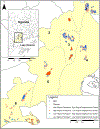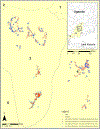Perceived HIV stigma and HIV testing among men and women in rural Uganda: a population-based study
- PMID: 32910903
- PMCID: PMC9706443
- DOI: 10.1016/S2352-3018(20)30198-3
Perceived HIV stigma and HIV testing among men and women in rural Uganda: a population-based study
Abstract
Background: Stigma is a formidable social structural barrier to HIV testing, and yet the effect of stigma on HIV testing is rarely examined at the community level. We aimed to examine the geospatial relationships of perceived HIV stigma and HIV testing among men and women living in rural Uganda.
Methods: Women and men (aged ≥18 years or emancipated minor) residing in rural areas of Uganda who self-identified as HIV negative completed interviews that included measures of HIV testing history and how participants perceived HIV stigma. We used geospatial cluster analyses to identify areas of higher perceived stigma and lower perceived stigma and the geographical dispersion of these areas. We used Poisson regression models stratified by gender to test individual-level and community-level perceived stigma in relation to frequency of HIV testing in the previous 2 years.
Findings: Between Nov 25, 2015, and May 26, 2017, we interviewed 9740 participants (4359 [45%] men and 5381 [55%] women]), among whom 940 (9%) had never been tested for HIV, and among those who had been tested, 1131 (12%) had not been tested in the previous 2 years. Men (3134 [72%] of 4359) were less likely to have been tested in the past 2 years than women (4535 [84%] of 5381) were (p<0·001). We used Poisson regression models, reporting B coefficients, to test study hypotheses regarding the effects of individual-level and community-level stigma on HIV testing frequency counts. Multilevel modelling showed that women showed significant individual-level (B=-0·173, p<0·001) and community-level (B=-0·223, p<0·001) associations between lower stigma predicting higher rates of HIV testing. For men, lower individual-level perceived stigma was also associated with higher testing frequency (B=-0·030, p=0·018), whereas higher community-level perceived stigma was associated with higher testing frequency (B=0·077, p=0·008).
Interpretation: Our results suggest that perceived HIV stigma at the community level exerts a differential influence on testing for women and men. HIV testing campaigns that are targeted to men and women in rural Uganda will require gender tailoring to fit local contexts.
Funding: US National Institute of Mental Health.
Copyright © 2020 Elsevier Ltd. All rights reserved.
Conflict of interest statement
Declaration of Interests
The authors declare no competing interests.
Figures


Similar articles
-
Intersecting stigma and HIV testing practices among urban refugee adolescents and youth in Kampala, Uganda: qualitative findings.J Int AIDS Soc. 2021 Mar;24(3):e25674. doi: 10.1002/jia2.25674. J Int AIDS Soc. 2021. PMID: 33713571 Free PMC article.
-
Factors influencing the uptake of voluntary HIV counseling and testing in rural Ethiopia: a cross sectional study.BMC Public Health. 2016 Mar 8;16:239. doi: 10.1186/s12889-016-2918-z. BMC Public Health. 2016. PMID: 26955869 Free PMC article.
-
Income Inequality, HIV Stigma, and Preventing HIV Disease Progression in Rural Communities.Prev Sci. 2019 Oct;20(7):1066-1073. doi: 10.1007/s11121-019-01013-5. Prev Sci. 2019. PMID: 30955136 Free PMC article.
-
HIV-related stigma and associated factors: a systematic review and meta-analysis.Front Public Health. 2024 Jul 23;12:1356430. doi: 10.3389/fpubh.2024.1356430. eCollection 2024. Front Public Health. 2024. PMID: 39109161 Free PMC article.
-
The impact of HIV on agricultural livelihoods in southern Uganda and the challenges of attribution.Trop Med Int Health. 2011 Mar;16(3):324-33. doi: 10.1111/j.1365-3156.2010.02703.x. Epub 2010 Dec 3. Trop Med Int Health. 2011. PMID: 21129134 Review.
Cited by
-
Associations between HIV testing and multilevel stigmas among gay men and other men who have sex with men in nine urban centers across the United States.BMC Health Serv Res. 2022 Sep 20;22(1):1179. doi: 10.1186/s12913-022-08572-4. BMC Health Serv Res. 2022. PMID: 36127682 Free PMC article.
-
Characterising People who inject drugs, and association with HIV infection: A Situation Analysis in Kampala city, Uganda.medRxiv [Preprint]. 2024 Jun 1:2024.05.31.24308282. doi: 10.1101/2024.05.31.24308282. medRxiv. 2024. Update in: PLOS Glob Public Health. 2025 Feb 26;5(2):e0003370. doi: 10.1371/journal.pgph.0003370. PMID: 38853844 Free PMC article. Updated. Preprint.
-
HIV-related stigma experiences and coping strategies among pregnant women in rural Uganda: A qualitative descriptive study.PLoS One. 2022 Oct 7;17(10):e0272931. doi: 10.1371/journal.pone.0272931. eCollection 2022. PLoS One. 2022. PMID: 36206276 Free PMC article.
-
Development, Implementation, and Scale Up of the National Furaha Yangu Campaign to Promote HIV Test and Treat Services Uptake Among Men in Tanzania.Am J Mens Health. 2022 Mar-Apr;16(2):15579883221087838. doi: 10.1177/15579883221087838. Am J Mens Health. 2022. PMID: 35333688 Free PMC article.
-
Sexual and Gender Minorities Inclusion and Uptake of Sexual and Reproductive Health Services: A Scoping Review of Literature.Am J Mens Health. 2023 Jul-Aug;17(4):15579883231184078. doi: 10.1177/15579883231184078. Am J Mens Health. 2023. PMID: 37395415 Free PMC article.
References
Publication types
MeSH terms
Grants and funding
LinkOut - more resources
Full Text Sources
Medical
Miscellaneous

